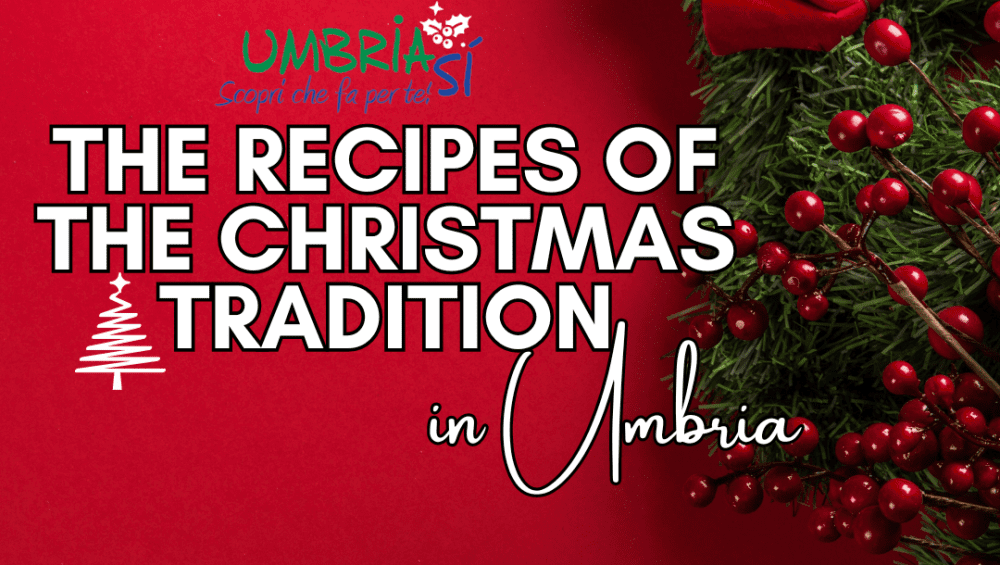Christmas Flavor in Umbria: A Culinary Journey through Typical Recipes
Christmas is a magical celebration, and what better way to celebrate it than immersing oneself in the culinary traditions of a region rich in history and authenticity? In Umbria, the Christmas table is a true spectacle of flavors, with dishes that reflect generosity and love for local traditions. In this article, we will explore some of the typical Christmas recipes in Umbria, offering a taste of the gastronomic heritage that makes this region unique.
The typical family Christmas menu in Umbria.
Appetizers:
Chicken Liver Crostini
A simple recipe, typical of the peasant tradition in this region, widely spread and appreciated throughout Central Italy. Chicken liver pâté crostini are always present on the table, especially during the holiday season. It is an appetizer with a very distinctive flavor, slightly tangy and quite savory. The pâté is made with chicken livers and is excellent when paired with Umbrian rustic bread – known for being low in salt – lightly toasted. The warm and fragrant crostini served with this flavorful sauce pairs well with a good glass of local red wine.
Chicken Galantine
An Umbrian dish considered a classic of Christmas lunch in the regional tradition. It seems that it was usually the housewives who cooked it in exchange for money or, more often, according to simple barter rules, for other essential products. It can be reasonably assumed that not only did every town, fortress, or village exhibit its own galantine recipe, claiming it to be the best, but every woman or man who ventured into the task had their own personal interpretation. This stuffed chicken terrine is both majestic, intimidating, and instructive. We could consider it a kind of relic of “synthetic” cuisine, as it puts everything (literally everything) together. It’s also a bit like a Chinese puzzle box, as each element is skillfully fitted inside the other. It starts with the chicken, deboned and gutted. The outer layer is filled with meat (chicken, beef, salted tongue, ground pork), eggs, mortadella (but also ham and lard), pistachios, cream, truffles. The resulting food chimera is secured with sturdy strings (twine), cooked in broth, and, once cooled, served in slices with chicken jelly.
First Course:
Cappelletti in Broth
Homemade cappelletti are a must during the Christmas holidays in Umbria. These small ravioli filled with beef and pork are cooked and served in a rich broth, providing warmth and comfort to diners during the cold winter days.
Second Course:
Stewed Capon
It is a castrated rooster cooked slowly in a rich sauce based on red wine and aromas such as rosemary and bay leaves. The capon is marinated with garlic, white wine, and herbs before cooking. Often accompanied by side dishes like mashed potatoes, Stewed Capon represents Umbrian culinary tradition, offering a tasty dish symbolizing conviviality.
Desserts:
Panpepato
Panpepato is one of the most beloved Christmas delicacies in Umbria. A mixture of nuts, almonds, candied fruit, honey, chocolate, and a myriad of spices, this sweet recalls the Sienese panforte but with a unique Umbrian touch. It is a true explosion of Christmas flavors that delights the senses.
Torciglione
Among the typical Umbrian Christmas sweets, there is one with a very particular shape: torciglione. Its origins are still uncertain: some claim that its shape resembles a lake eel, others that of a snake. Regardless of its history, it is a famous sweet throughout the region, with various versions that can vary in dosage or the presence of certain ingredients, but especially in the final decorations, leaving ample space for creativity.
Rocciata
A traditional sweet during the winter holiday period (from early November to Carnival), mainly prepared at Christmas, roc- ciata is a typical recipe of Foligno, Assisi, and Spello. Its spiral shape resembles that of a snake coiled upon itself, and its red color is given by alchermes. Inside the dough, a rich filling of cooked apples with walnuts, almonds, pine nuts, dried figs, raisins, and chocolate. Naturally, there are variations based on the area and family traditions, which usually remain secret!
Pinoccata
Traditional Christmas sweets in Perugia, pinoccate are packaged in colorful and festive papers that brighten shop windows, gift baskets, and tables. It seems that these sweets were in use among Benedictine monks since the 14th century and were still consumed at the end of lavish Christmas lunches in the late 18th century.
Almost exclusive to the Umbrian capital, this sweet owes its name, known in variations such as pinoccati, pinocchiati, pinoccate, and pinocchiate, to pine nuts, formerly more frequently called pinocchi, which constitute its main ingredient and give it an unusual and spicy taste. It consists of a mixture composed only of water and sugar boiled until obtaining a thick syrup, in which a quantity of pine nuts almost equivalent to that of sugar is immersed. On half of the dough, from which many small diamonds will then be drawn, cocoa is added, useful to dampen the excessive sweet taste and also to diversify these products, then wrapped in pairs: one white and the other black.
The contrast between the two colors seems to evoke medieval decorative taste when very distant colors were approached, a taste found in architecture, decorative arts, but also in coats of arms, shields, banners, and banners (not to mention games – from checkers to chess – and city factions like whites and blacks). The packaging with which the sweet is presented seems to refer to the same medieval and Renaissance world: wrapped in paper as if it were a large candy, it is similar to those “throwing sweets” that were actually thrown during mock battles between knights and in tournaments of the feasts of those distant times.



